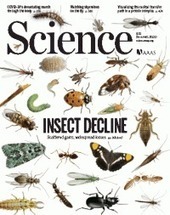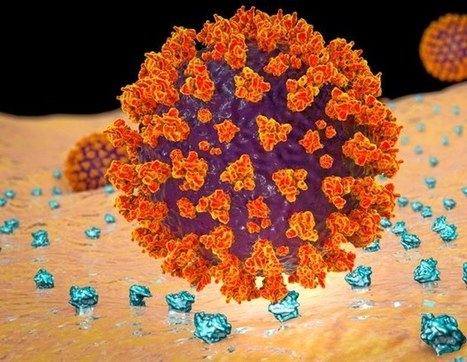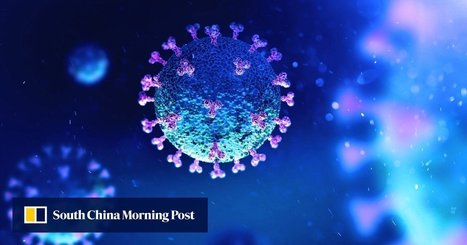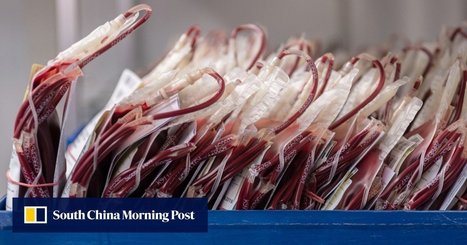 Your new post is loading...
 Your new post is loading...

|
Scooped by
Gilbert C FAURE
April 26, 2020 7:05 AM
|
从1月23号我市正式封城以来,历时3个多月到今天4月26号止:
新增确诊病例为0
新增疑似病例为0
现存确诊病例为0
现存疑似病例为0
#现已全部清零!

|
Scooped by
Gilbert C FAURE
April 24, 2020 3:08 AM
|

|
Scooped by
Gilbert C FAURE
April 22, 2020 2:24 PM
|
-
Presence of SARS-CoV-2-reactive T cells in COVID-19 patients and healthy donors

|
Rescooped by
Gilbert C FAURE
from Virus World
April 22, 2020 5:02 AM
|
Researchers in British Columbia have identified a set of gene variants that are likely to influence disease progression from severe acute respiratory syndrome coronavirus 2 (SARS-CoV-2) infection to COVID-19 disease. They have identified a rare set of variants in specific amino acid residues on the protein angiotensin-converting enzyme 2 (ACE2) that affect the viral spike protein’s ability to bind to and enter human cells. A spike protein is a key structural protein on the surface of SARS-CoV and SARS-CoV2 (the causative agent in COVID-19) virions that enables interaction with human cell receptors and fusion with the host cell membrane.... For their study, the team used the gnomAD database – a resource cataloging genetic coding variants for 141,456 adults. They assessed entries on ACE2 in the database and downloaded files predicting missense variants in the protein. The database cataloged 242 coding missense variants, 15 of which were predicted to be located at or close to the ACE2 binding site for SARS-CoV-2 spike protein. On aggregating the frequency of these variants, the team estimated that they occur in approximately 3.9 per 1,000 males and 8.5 per 1,000 females. However, the distribution of these rare alleles is not even across subpopulations, and the only common one was rs41303171 (thought to encode p.Asn720Asp), which occurred in 1.7% of males and 3.2% of females in the database. Although the occurrence of this allele was frequent enough to be identified in genome-wide association studies, it does not lie in the ACE2 domain thought to be bound by SARS-CoV-2 and was therefore not considered a worthwhile candidate for this interaction. The second most common variant was rs4646116 (thought to encode p.Lys26Arg), which was predicted to lie next to the ACE2-Spike protein interface. Preprint of the original study available at bioRxiV (April 14, 2020): https://www.biorxiv.org/content/10.1101/2020.04.05.026633v1
Via Juan Lama

|
Scooped by
Gilbert C FAURE
April 21, 2020 2:20 PM
|

|
Scooped by
Gilbert C FAURE
April 20, 2020 2:03 PM
|

|
Scooped by
Gilbert C FAURE
April 16, 2020 5:18 AM
|
The next British Society for Immunology 'Connecting on coronavirus' webinar will take place on Friday 17 April 2020 from 11:30-12:15 BST. This session will be hosted by Professor Danny Altmann.

|
Scooped by
Gilbert C FAURE
April 14, 2020 11:48 AM
|
Hydroxychloroquine in patients with COVID-19: an open-label, randomized, controlled trial

|
Scooped by
Gilbert C FAURE
April 13, 2020 6:47 AM
|
13th April Natural Killer (NK) cells and CD8+ Cytotoxic T Lymphocytes (CTLs) play key roles in the control of viral infections. Zheng et al have studied the

|
Scooped by
Gilbert C FAURE
April 12, 2020 6:23 AM
|
Spécialiste des reprises improbables, l'animateur TV américain Jimmy Fallon avait invité Sting et le groupe The Roots à reprendre une chanson de circonstance: "Don't Stand So Close To Me". Buzz garanti.

|
Scooped by
Gilbert C FAURE
April 10, 2020 3:15 AM
|
Although the respiratory and immune systems are the major targets of Coronavirus Disease 2019 (COVID-19), acute kidney injury and proteinuria have also been observed. Currently, detailed pathologic examination of kidney damage in critically ill patients with COVID-19 has been lacking. To help define this we analyzed kidney abnormalities in 26 autopsies of patients with COVID-19 by light microscopy, ultrastructural observation and immunostaining. Patients were on average 69 years (19 male and 7 female) with respiratory failure associated with multiple organ dysfunction syndrome as the cause of death. Nine of the 26 showed clinical signs of kidney injury that included increased serum creatinine and/or new-onset proteinuria. By light microscopy, diffuse proximal tubule injury with the loss of brush border, non-isometric vacuolar degeneration, and even frank necrosis was observed. Occasional hemosiderin granules and pigmented casts were identified. There were prominent erythrocyte aggregates obstructing the lumen of capillaries without platelet or fibrinoid material. Evidence of vasculitis, interstitial inflammation or hemorrhage was absent. Electron microscopic examination showed clusters of coronavirus particles with distinctive spikes in the tubular epithelium and podocytes. Furthermore, the receptor of SARS-CoV-2, ACE2 was found to be upregulated in patients with COVID-19, and immunostaining with SARS-CoV nucleoprotein antibody was positive in tubules. In addition to the direct virulence of SARS-CoV-2, factors contributing to acute kidney injury included systemic hypoxia, abnormal coagulation, and possible drug or hyperventilation-relevant rhabdomyolysis. Thus, our studies provide direct evidence of the invasion of SARSCoV-2 into kidney tissue. These findings will greatly add to the current understanding of SARS-CoV-2 infection.

|
Scooped by
Gilbert C FAURE
April 8, 2020 3:04 AM
|
bioRxiv - the preprint server for biology, operated by Cold Spring Harbor Laboratory, a research and educational institution

|
Scooped by
Gilbert C FAURE
April 7, 2020 2:49 AM
|
ACE tissular repartition and cardiac disorders
|

|
Scooped by
Gilbert C FAURE
April 25, 2020 4:20 AM
|
Cardiovascular complications are rapidly emerging as a key threat in coronavirus disease
2019 (COVID-19) in addition to respiratory disease. The mechanisms underlying the
disproportionate effect of severe acute respiratory syndrome coronavirus 2 (SARS-CoV-2)
infection on patients with cardiovascular comorbidities, however, remain incompletely
understood.1,2

|
Scooped by
Gilbert C FAURE
April 23, 2020 1:41 PM
|
medRxiv - The Preprint Server for Health Sciences

|
Scooped by
Gilbert C FAURE
April 22, 2020 2:50 AM
|
Proper management of COVID-19 mandates better understanding of disease pathogenesis.
Giamarellos-Bourboulis et al. describe two main features preceding severe respiratory
failure associated with COVID-19: the first is macrophage activation syndrome; the
second is defective antigen-presentation driven by interleukin-6. An IL-6 blocker
partially rescues immune dysregulation in vitro and in patients.

|
Scooped by
Gilbert C FAURE
April 21, 2020 2:30 PM
|
immunogénétique et Covid-19

|
Scooped by
Gilbert C FAURE
April 21, 2020 4:23 AM
|
Currently, there is very limited knowledge of the host immune response to SARS-CoV-2. However, based on the clinical and experimental data on SARS-CoV and MERS-CoV predictions can be made on how the host immune system will respond and possibly viral evasion strategies.

|
Scooped by
Gilbert C FAURE
April 20, 2020 7:27 AM
|
In a short span of time, COVID-19 has become a rapidly spreading communicable disease forcing the WHO to declare it as the "Public Health Emergency of International Concern" on January 30. As of April 16, the WHO pandemic update indicates a whopping 1,991,562 confirmed reporte

|
Scooped by
Gilbert C FAURE
April 15, 2020 10:39 AM
|
A l'heure où les mesures de confinement de la ville de Wuhan sont levées, je voulais vous dire ma joie de voir revivre la ville, mais aussi exprimer à nouveau mes très sincères condoléances à toutes celles et tous ceux qui pendant cette épreuve ont perdu un parent, un proche, un ami.

|
Scooped by
Gilbert C FAURE
April 13, 2020 7:58 AM
|
Researchers in China and the US find that the virus that causes Covid-19 can destroy the T cells that are supposed to protect the body from harmful invaders.

|
Rescooped by
Gilbert C FAURE
from Virus World
April 13, 2020 3:13 AM
|
Scientists in Shanghai say some recovered patients show no signs of the neutralising proteins. Researchers in Shanghai hope to determine whether some recovered coronavirus patients have a higher risk of reinfection after finding surprisingly low levels of Covid-19 antibodies in a number of people discharged from hospital. A team from Fudan University analysed blood samples from 175 patients discharged from the Shanghai Public Health Clinical Centre and found that nearly a third had unexpectedly low levels of antibodies. In some cases, antibodies could not be detected at all. “Whether these patients were at high risk of rebound or reinfection should be explored in further studies,” the team wrote in preliminary research released on Monday on Medrxiv.org, an online platform for preprint papers. Although the study was preliminary and not peer-reviewed, it was the world’s first systematic examination of antibody levels in patients who had recovered from Covid-19, the disease caused by the coronavirus, the researchers said. All of the patients had recently recovered from mild symptoms of the disease and most of those with low antibody levels were young. The researchers excluded patients who had been admitted to intensive care units because many of them already had antibodies from donated blood plasma.... Preprint of the original Report in medRxiv (April 6, 2020):
Via Juan Lama
Abstract The 2019 novel coronavirus (2019-nCoV) outbreak has caused a large number of deaths with thousands of confirmed cases worldwide, especially in East Asia This study took an immunoinformatics approach to identify significant cytotoxic T lymphocyte (CTL) and B cell epitopes in the 2019-nCoV surface glycoprotein Also, interactions between identified CTL epitopes and their corresponding MHC class I supertype representatives prevalent in China were studied by molecular dynamics simulations We identified five CTL epitopes, three sequential B cell epitopes and five discontinuous B cell epitopes in the viral surface glycoprotein Also, during simulations, the CTL epitopes were observed to be binding MHC class I peptide-binding grooves via multiple contacts, with continuous hydrogen bonds and salt bridge anchors, indicating their potential in generating immune responses Some of these identified epitopes can be potential candidates for development of 2019-nCoV vaccines
Via Krishan Maggon

|
Scooped by
Gilbert C FAURE
April 9, 2020 1:39 PM
|
The crystal structure of the C-terminal domain of the SARS-CoV-2 spike protein in
complex with human ACE2 reveals insights into the mechanisms of binding of this virus
and its differences from SARS.

|
Scooped by
Gilbert C FAURE
April 8, 2020 2:51 AM
|
|
 Your new post is loading...
Your new post is loading...
 Your new post is loading...
Your new post is loading...
























